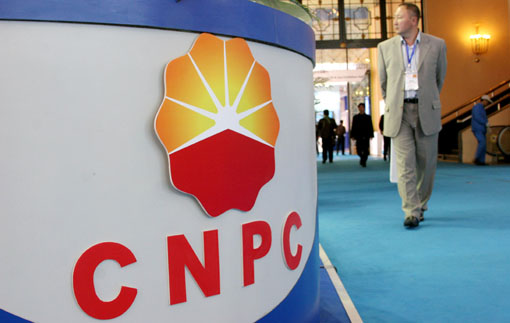
China Makes Strides in Energy “Go-out” Strategy
Publication: China Brief Volume: 9 Issue: 15
By:

In recent months, Chinese National Oil Companies (NOCs) struck four major overseas energy deals with Russia, Kazakhstan, Brazil and Venezuela for a combined value of nearly $50 billion in Chinese capital (Dow Jones News, February 17). The growing footprint and outreach of these NOCs have stoked concerns that Beijing is maneuvering to lock-up global energy assets [1]. Indeed, China has grown to become the world’s second largest consumer and importer of oil, and the government has been pushing its NOCs to implement a “go-out” strategy to secure overseas energy supply. Yet this new strategy is taking the shape of a formula of “loans-for-energy,” which involves a mix of state-owned and private actors. These complex arrangements indicate that China’s expansion of overseas-energy assets is a long term goal and that it is increasingly interested in securing Chinese outward investments from its international partners.
Four major deals in one month
In February, CNPC signed a raft of agreements with Moscow, in which China would provide $25 billion in soft loans to Russia in return for a long-term commitment to supply China with oil. In the same month, China and Venezuela agreed to double their joint investment fund to $12 billion by injecting an additional $4 billion from China, in return for Venezuela’s state-run oil company PDVSA’s commitment to sell CNPC between 80,000-200,000 barrels of oil per day (bpd) by 2015 (Asia Pulse, March 11). On February 19, China Development Bank, a financial institution under the State Council primarily responsible for raising funds for large infrastructure projects, sealed a similar deal with Petrobras—the Brazilian state-owned oil major—for a Chinese loan of $10 billion in exchange for a 10-year oil supply memorandum. This agreement will allow China’s Sinopec and CNPC to receive up to 150,000 bpd beginning this year, increasing to 200,000 bpd in the next nine years (Dow Jones Chinese Financial Wire, May 19). China’s fourth “loans-for-oil” deal, which was also signed in February, was with Kazakhstan. Under the terms of the contract, Kazakhstan will receive $10 billion in financing for its oil projects. China’s Export and Import Bank (Exim Bank), the official export credit agency of the Chinese government, lent the state-owned Development Bank of Kazakhstan $5 billion, while CNPC extended a $5 billion loan to its Kazakh counterpart KazMunaiGas (Reuters, April 17).
Complex “Loans-for-Oil” Formula
The four aforementioned deals all entail extensive and complicated negotiations between the parties involved, and they all involve arrangements in what the Chinese call “loans-for-oil” (daikuan huan shiyuo).
China’s $25 billion deal with Russia, for example, is comprised of four separate core agreements—two loan agreements between China Development Bank and Russian oil firms Rosneft and Transneft, respectively; one oil supply agreement between CNPC and Rosneft; plus one oil pipeline construction and operation agreement between CNPC and Transneft. Under the provisions of the two loan agreements, Russian firms must use Chinese loans for projects related to oil supplies that are going to China, but Rosneft is also permitted to use part of the loan to repay its debts to other non-Chinese financial institutes (Caijing, February 20). These agreements could potentially secure oil supplies amounting to 300 million tons over 20 years. The supplies are worth almost $90 billion at current prices.
Yet it would be inaccurate to presume that China is buying $90 billion worth of oil with $25 billion of loan. Instead, China is expected to buy the oil at market price at the time of delivery, and Russia will pay back the loans separately in cash, under an adjustable interest rate. In other words, it may be somewhat misleading to describe the deals as “loans-for-oil.”
These arrangements also mean that the construction of a 300,000 bpd link from the Eastern Siberia–Pacific Ocean (ESPO) oil pipeline to China can now be materialized (Platts Commodity News, February 17). The long-awaited 1030 km pipeline starts from Skovorodino in the Far East of Russia, and ends at the Daqing oilfield in China’s Heilongjiang province (China Chemical Reporter, June 6). Once finished at the end of 2010, the pipeline has a capacity to transport 15 million tons of oil to China every year, enough to meet around four percent of China’s current oil needs (Interfax, February 17). Rosneft expects to send crude to China under the new deal beginning in January 2011 (Xinhua News Agency, April 23).
The Petrobras-CNPC/Sinopec deal departs from the former’s usual practice of not entering into contracts committing future production and supply in its new agreement with China. It demonstrates that Petrobras is eager to keep financing on track for its pre-salt exploration in newly found oil reserves (for 8 billion barrel potential) deep beneath the ocean floor off Brazil’s southern coast. The entire project requires a $174.4 billion investment, and $28.6 billion input for this year alone (LatinFinance, April 29; Reuters, May 19). On the Chinese side, the 150,000 bpd that Petrobras has promised Sinopec for 2009 would be equivalent to around 4.2 percent of China’s overall intake in 2008 (Platts Oilgram News, May 21).
The agreement with Venezuela is the least definite in contrast to the other three, as it contains no firm commitment of increasing its supply of oil, but only based on loosely-phrased terms “calling for” PDVSA to sell CNPC between 80,000-200,000 barrels of oil per day" (The Associated Press, May 13). During his April 2009 visit to China, Venezuelan President Hugo Chavez announced that the country aims to increase oil shipments to China to one million barrels per day by 2010, as grand a scheme as it may sound, and it is worth noting that Caracas’s petroleum shipments to China only reached 168,000 bpd by December 2008, which fell way short of Chavez’s original target of 400,000 bpd for 2008 (Bloomberg, January 27).
China’s new venture with Kazakhstan deviates from the “oil-for-loans” formula. The $5 billion loan from CNPC will give Chinese oil firms a 50 percent stake in the joint purchase of MangistauMunaiGaz (MMG), Kazakhstan’s biggest private oil and gas company (Reuters, April 17). This deal is more like a “loan-for-oil assets” transaction than one of “loan-for-promised-oil supply," which characterizes the previous three contracts, and CNPC will receive half of the oil that will be produced by the jointly owned MMG (the other 50 percent will be owned by the Kazak state-owned firm KazMunaiGas). This model is more in line with the Chinese government’s preference for financing acquisitions, since it gives Chinese NOCs direct ownership of resources. In contrast to the other three deals, Chinese NOCs could only extend loans to foreign NOCs for guaranteed oil supplies or possible special access to future exploration projects.
China’s inability to obtain outright equity oil assets stems mainly from the oil exporters’ mailed grip of their national resources. The increasing nationalistic sentiments evoked by oil-producing countries and the use of energy as a national foreign policy tool suggest that—at least in the short term—these deals far from signal a major breakthrough in China’s energy security. Since China was only able to secure 50 percent interest from Kazakstan’s MMG, and uncertainty remains as to whether the promised oil supplies are sustainable on a long-term basis without occasional disruption.
Underlying conditions
The global financial crisis — The “loans-for-oil” deals are unfolding against the backdrop of the global financial crisis and abated global oil consumption. Take Russia for example. Rosneft, 75 percent controlled by the government, was burdened with $21.2 billion in debt and Transneft with $7.7 billion (Xinhua News Agency, May 19). For Rosneft, its $15 billion share of the $25 billion loan from China will comfortably cover its $8.5 billion debt maturing this year (Financial Times, February 18). In addition, China’s capital injection complements the emergency capital needs of national oil firms in Venezuela and Brazil, allowing them to further expand their market shares and turning resources into capital. As for Kazakhstan, Xue Li from the Chinese Academy of Social Science points out that China’s $10 billion loan could help the Central Asian country initiate its $14.6 billion dollar economic recovery policy (Xinhua News Agency, April 19).
Put more of China’s $2 trillion foreign reserves into hard assets — Zhang Guobao, vice minister of the National Development and Reform Commission and head of the NEA, had pointed out in a signed article published in December 2008 in the People’s Daily (a strong indication of being authoritative statements of government policy) that China should seize the timing of the oil price slump on the international market to increase imports and Chinese enterprises are encouraged by the government to expand overseas (China Daily, March 9). Accompanying such appeals is a call is to take advantage of China’s fast-accumulating foreign reserves. The global economic crisis has presented China with a rare opportunity to trade its abundant foreign currency reserves for oil, mineral and other resources around the world. China now has roughly $2 trillion in foreign exchange, ranking number one in the world, and many state firms are also flush with funds (The Associated Press, February 18). Beijing is considering setting up an oil stabilization fund to support purchases of overseas resources by Chinese oil companies. The plan was submitted at NEA’s National Work Conference on Energy held in March 2009 (Xinhua News Agency, March 2).
Oil-producing nations trying to diversify export-markets — China offers oil-producing nations, especially Russia and Venezuela, an alternative to Western and U.S. markets, thereby giving them more political clout in the international community and reducing potential vulnerability from their existing buyers. The Russian government plans to increase its crude oil exports to the Asia-Pacific region from three percent in 2000 to 30 percent by 2020, amounting to 100 million tons a year [2]. Similarly, Venezuela regards China as a key link in its strategy of diversifying oil sales away from the United States, which still buys about half of its oil despite years of political tensions. The rationale also applies to Kazakhstan. In addition to pipelines extending to Russia and Europe, sustainable oil supplies through the existing China-Kazakhstan oil pipeline can enhance Kazakhstan’s energy transit potential by diversify its exporting routes, thereby reducing political and commercial risks.
Assessments and Prospects
The recent large energy activities are not the first time Chinese NOCs have entered “loans-for-oil” deals. In 2004, Chinese banks financed Rosneft’s acquisition of Yuganskneftegaz with a $6 billion loan and CNPC received a pledge of long-term supply contracts via rail in exchange (Platts Community News, February 19). Beijing’s continuous efforts to secure long-term oil supplies demonstrate that Chinese national oil firms are increasingly using a powerful tool to obtain overseas assets: loan from government banks to resource-rich but cash-strained nations in maintaining access to oil supplies.
Yet even under economic pressure, oil-producing countries have kept Chinese oil companies at arms’ length during the negotiation. For the former, these four deals represent an optimal outcome—let China provide the financing while they maintain the control of the energy assets. The terms of the agreements only give China the "right to purchase" the oil, but not the "right to own" the oil through equity purchase.
These “loans-for-oil” activities will remain an active component of the Chinese overseas resource acquisition strategy given the current global economic and energy conditions. They are accompanied by Chinese NOCs other commercial and acquisition, such as the latest commitment of $7.2 billion by Sinopec to buy Toronto listed Addax which has large holdings in West Africa and Iraq (Wall Street Journal, June 25). The Sinopec-Addax transaction, if finalized, will be the single largest energy asset purchase by the China’s NOCs, demonstrating the dynamic nature of China’s overseas energy security drive.
[The author would like to thank Simin Yu for his research assistance.]
Notes
1. Chinese NOCs normally refer to the China National Petroleum Corporation (CNPC), China Petroleum and Chemical Corporation (Sinopec), China National Offshore Oil Corporation (CNOOC), and their subsidiaries.
2. Shoichi Itoh, “Russia’s Energy Diplomacy toward the Asia-Pacific: Is Moscow’s Ambition Dashed?” Slavic Research Center, Sapporo, Japan, 2008.





